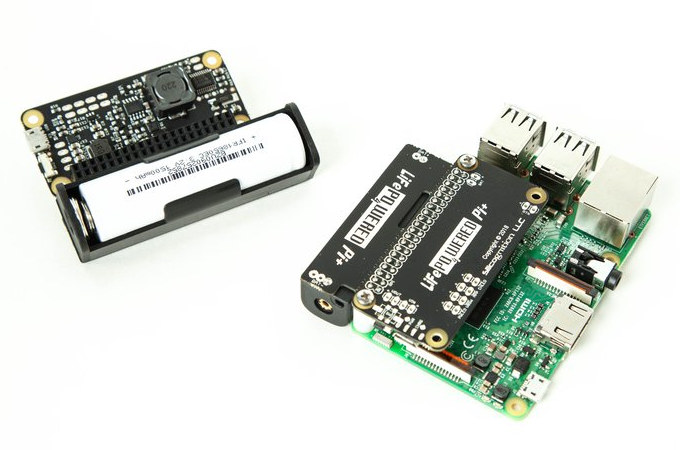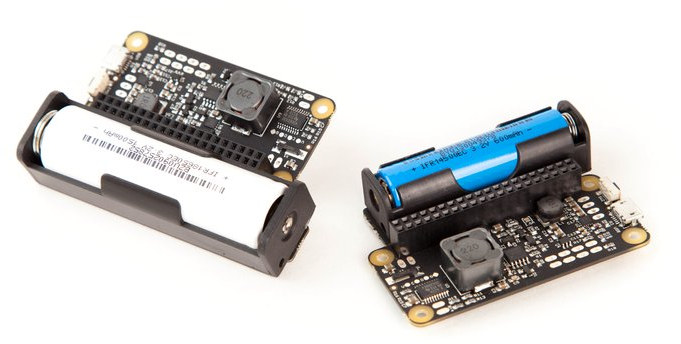We’ve already covered several UPS solution for Raspberry Pi boards, but LiFePO4wered/Pi+ is a little different because instead of relying on LiPo (Lithium Ion Polymer) batteries, it comes with LiFePO4 (Lithium Iron Phosphate) battery which are said to be safer and longer-lasting albeit at the cost of lower capacity.
 LiFePO4wered/Pi+ specifications:
LiFePO4wered/Pi+ specifications:
- Two battery size options:
- 18650 size – 1,500 mAh 3.2 V LiFePO4 cell with up to 2A max continuous load current
- 14500 size – 600 mAh, 3.2 V LiFePO4 cell with up to 0.75 A max continuous load current
- Smart charge controller – Over-charge protection, auto-adjusting charge current, customizable maximum power point (MPP) voltage
- Smart power manager:
- I2C communication
- Power manager and daemon – work together to ensure clean shutdowns and provide over-discharge protection
- Continuous monitoring – input voltage, battery voltage, output voltage, and load current
- On/off button
- Green PWR LED & Red CHRG LED
- Wake timer – Wakes up RPi as needed for low duty cycle applications.
- Real-time clock
- Auto boot
- Auto shutdown when input power is removed, either immediately or after a programmable amount of time.
- Application watchdog – Flash the PWR LED or trigger a shutdown/reboot if the user application fails to service the timer within a configurable amount of time.
- Dimensions
- 18650 size – 52 mm x 75 mm
- 14500 size – 47 mm x 65 mm
Beside the Raspberry Pi boards, the board has been tested with Odroid-C2, NanoPi S2, some Allwinner H3 boards, and ASUS Tinker Board. It should work with any board compatible with the 40-pin RPi header.

LiFePO4wered/Pi+ board can power a Raspberry Pi for up to nine hours from its battery. Silicognition LLC – the company behind the project – provide several open source host-side tools and software package namely LiFePO4wered daemon that takes care of shutdown and RTC management, lifepo4wered-cli command line tool for configuration and access to all features, as well as shared libraries with language bindings for C/C++, Python and Node.js, all of which can be found in their GitHub repo.
Some of the advantage of Lithium Iron Phosphate (LiFePO4) batteries over LiPo batteries include:
- High continuous load current
- Longer lasting with thousands of recharge cycles, instead of just hundreds
- Safer, as they don’t catch fire or explode
- More Stable: 3.2 – 3.3 V during most of discharge
- More durable with low self-discharge rate, no memory effects, no degradation from extended charging
- Environmentally friendly with no heavy metals, RoHS compliant, and reusable thousands of times
- Better suited to rough environments, as they can operate in both cold (down to -20°C) and hot (up to 60°C) temperatures.
The UPS / battery management board is now offered on CrowdSupply where you can pledge $39 for the 14500 kit with a 600 mAh battery, or $45 for the 18600 kit with a 1,500 mAh battery. Shipping is free to the US, but adds $10 to the rest of the world. Delivery is scheduled for the end of October 2018 (14500 battery kit) or January 2019 (18600 battery kit).

Jean-Luc started CNX Software in 2010 as a part-time endeavor, before quitting his job as a software engineering manager, and starting to write daily news, and reviews full time later in 2011.
Support CNX Software! Donate via cryptocurrencies, become a Patron on Patreon, or purchase goods on Amazon or Aliexpress. We also use affiliate links in articles to earn commissions if you make a purchase after clicking on those links.




Users of some of the Allwinner H3 boards with rotated GPIO header (at least Orange Pi One and Lite) need to take care that this UPS won’t fit. And position of the UPS on most boards will make heat dissipation even more of a challenge. Especially the RPi 3 B+ will be slowed down by anything covering the SoC: https://www.raspberrypi.org/forums/viewtopic.php?f=63&t=217056
BTW: The link to Crowdsupply needs to be fixed.
Keeping cooling adequate with a power mezzanine is a pain, I’ve been trying to find a “good enough” location for a fan mounting location on mine that will service most boards… Of course I’m not going to bother worrying about the “Zero” form factor…
Just a quick comment, the number of charge/discharge cycles has nothing to do with the chemistry but rather with the charging voltage. You roughly multiply the number of cycles by 10 for each 0.1V you remove from the top charge. Simply charging LiPos at 4.0V or even 3.9V is enough to make them last very long, at the expense of a lower capacity. I guess the new high voltage ones (4.35V) only rank in the few hundred cycles. However it’s true that LiFePo4 are way safer and will normally not cause a fire by being overly discharged, or even physically damaged.
Based on LiFePO4 house bank experience it is generally recommended that you do not charge below 5C. Discharge at low temps is OK
Did you mean half C? Because 5C is very large current and I would not feel safe using such.
He meant a temperature of 5 degrees Centigrade, not a 5C current rating.
Right, thanks. I missed talking about “temperature” and he did not use “°”.
Using “degrees centigrade” is deprecated, use Celsius instead to be technically accurate. And never “degrees Celsius”.
Confusion might arise between Celsius and Coulomb, which is the unit of charge (and not current which is in Amps)
I’m looking for a decent 12V UPS for my CPE, router, WiFi AP, etc.
I really have no need for an inverter and wallwarts with their inherent inefficiencies, and would ideally like a pure DC UPS capable of supplying approximately 3-5A for 1-2 hours or thereabouts.
I did find this (https://www.aliexpress.com/item/DC-UPS-power-module-Uninterrupted-power-Computer-Access-control-Security-DC-backup-power/32733826688.html) on AliExpress, that I hoped to use with an 8Ah lead acid battery, but found it impossible to calibrate it appropriately.
I’m surprised that there are not more of these around.
You could have a look at the so-called “12V lithium battery packs” which recharge and discharge via a 2.1/5.5mm jack. What’s interesting there is that the input and output connectors are in fact connected together, so the battery is installed in parallel to your PSU and will charge as long as there’s some juice, and will discharge into your equipment when you lose the power input. Most of them won’t deliver 5A though, but 2A will be OK. Don’t believe at all the amp-hours rating they indicate, it’s totally false, you need to divide by 2-3 in general. For example my 1.8Ah is advertised as 4Ah. But they’re very cheap and convenient, you’ll hardly find a cheaper UPS (typically around $15 for 2 Ah). You could have just one per device and avoid the need for a big one. I don’t know how many recharge/discharge cycles they support, I’m pretty sure the BMS inside is only a charge/discharge protection board and that there’s no balancing involved. So maybe you’ll lose some capacity after many cycles. But it’s cheap to test, and you don’t even need to buy the charger if you already have a compatible one. They need at least 12.6V input to be fully charged.
Thanks for the suggestion, I’ll take a look around.
What was the problem with that DC UPS board from Ali?
I was just yesterday looking at this board and thinking about buying it to make a DC UPS with 18650 pulls from laptop batteries.
I was just struggling to calibrate it, is all. Twiddling the various trimpots didn’t seem to make any difference.
There are many buffer power supply (might not be correct term to search them).
Small problem is that typical solution is to use charning voltage to to power devices, so you need to make sure all your receivers works with normal’s battery buffer cycle, that is from about 10V to 13.8-14V (depending on settings).
Really nice… But I’m using power bank with power passthru (20k mAh). Yeah a bit bigger, but easier to get.
> power bank with power passthru
You read the blog post? How does your powerbank compete against the 10 topics listed below ‘Smart power manager’?
It’s probably “good enough”? 🙂
I2C communication
Not a advantage in itself, just technical details about communication channel.
Power manager and daemon – work together to ensure clean shutdowns and provide over-discharge protection
Nice, but if power outages are rare and short, not needed.
Continuous monitoring – input voltage, battery voltage, output voltage, and load current
Same as previous.
On/off button
Nice, but not really that important, especially for 24/7/365 devices.
Green PWR LED & Red CHRG LED
Power bank includes something like this.
Wake timer – Wakes up RPi as needed for low duty cycle applications.
This is nice, but with such small capacity you need to recharge it often anyway.
Real-time clock
NTP or other half solutions possible.
Auto boot
Not important for 24/7/365 devices.
Auto shutdown when input power is removed, either immediately or after a programmable amount of time.
Again “Nice, but if power outages are rare and short, not needed.”
Application watchdog – Flash the PWR LED or trigger a shutdown/reboot if the user application fails to service the timer within a configurable amount of time.
Nice, but shutdown does not solve problem and reboot has big chance to corrupt SD filesystem.
I would probably choose power bank over this device in many situations.
If your could find similar thing which can power a pi for 16 hours and be charged from a solar panel, it would allow you to have an off-grid network of devices. Battery would need to charge up in 8 hours. I’m thinking of those of us in northern climates where winter days are shorter.